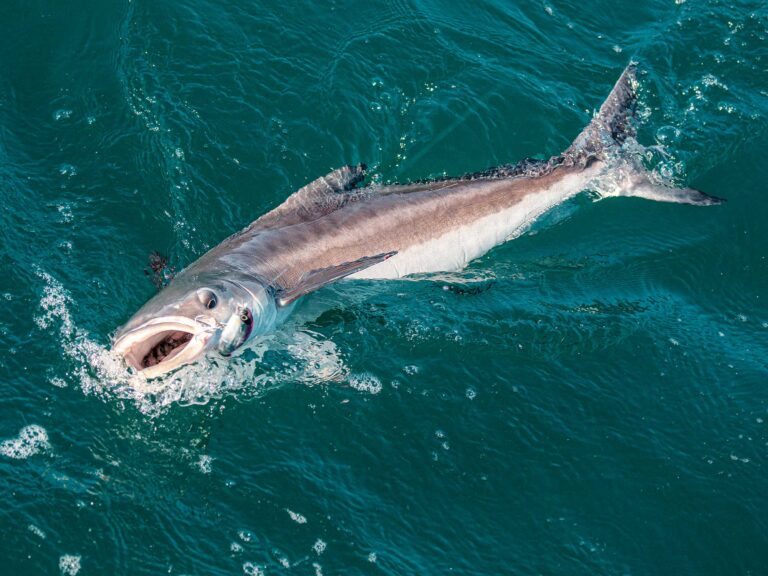
The year was 1991, and the striped bass population was near its all-time low. I was trolling off New Jersey’s Island Beach State Park, a spread of two bunker spoons on wire-line outfits trailing 300 feet behind my center console, when the clicker on the port-side reel screamed. Backing dwindled away at an alarming rate, and the rod bent so deeply, it seemed ready to explode. A big bass was doing its best to empty the reel in one powerful run.
The fish slowed with a few yards of line left on the spool, and the tide began to shift. Fifteen minutes later, the cow was rolling alongside the boat. We went back on the troll, and the scenario repeated itself — not once but numerous times in a two-hour period. We caught 11 bass, most in the mid- to high 30s, with three greater than 40 pounds. We released all of these fish minus the biggest, which tipped the scales at 46.6 pounds. At a time when bass were considered scarce as hen’s teeth, we were instant celebrities, and every fish fell for one of the oldest trolling lures in the book: the venerable bunker spoon.

Fast-forward to late April 2013 in the same place with a pair of spoons trolled 300 feet behind the boat in search of early-run stripers that my log indicated move through this area about this time. One of the rods dipped violently, the clicker screamed, and it was déjà vu all over again. The fight was impressive, and when it was over, the prespawn female hit the 50-pound mark on my Boga-Grip. She was gently revived and kicked her tail indignantly as she took off for the bottom. Bunker spoons — some things never change, or do they?
There are a lot more stripers around today after the stocks peaked at astronomical heights about six or seven years ago. There are also concerns that the current decline has been precipitous and that precautions need to be taken, and I can agree with that. Far too many big spawners have been taken over the past 10 years, and while many of the anglers I know, myself included, have not killed a big bass in many years, it’s time for everyone to re-evaluate his conservation ethic. But the fishery isn’t the only thing that’s changed in this scenario — so have bunker spoons and the ways they can be used. There are new spoon designs, more sizes to match a wider variety of baitfish, new wrinkles on depth control, and even techniques that put these deadly lures into play without wire. Welcome to the new age of the bunker spoon!

Spoon Innovator
Tony Arcabasio, aka Tony Maja, is an old-time Sandy Hook striper sharpy. More bass have passed over his gunwales than most anglers could catch in four lifetimes. He knows his quarry and has a passion for spoons, so when he started experimenting with his own designs some years ago, I was one of his guinea pigs. I pulled his early prototypes, and the results were startling. At first I thought they didn’t swim well because they imparted only a subtle action, but when they started to catch, I changed my mind. They got more hits and missed far fewer fish with just a single swinging hook than the old standbys got with more-fish-damaging trebles. They quickly became a go-to on my boat, and when Arcabasio started offering additional sizes and shapes to match everything from butterfish and herring to full-size menhaden, it greatly broadened their appeal. In addition to spoons, Arcabasio improved the outrodder and started tinkering with techniques that are changing the way spoons are fished today.

Get Down — Farther
One of the limitations of wire is that it reaches a point of diminishing returns in the depth department. More than 300 feet, and it just doesn’t sink the lures much more without adding weight. Adding a trolling drail to the rig works, but spoon expert Tony Arcabasio developed another method. It gets you deeper and adds a dancing teaser to the rig -without dulling the action of the spoon.
From the end of the wire, attach a short mono leader about 3 feet long, slide a 150-pound-test mini swivel onto it, and tie a second one to the end. Then tie about 12 feet of additional mono leader and a bead-chain-style swivel for attaching the spoon. Arcabasio recommends the bead for flash and better spoon action. From the sliding swivel, tie a 6- to 10-foot length of 60-pound braid, and tie on a 4- to 8-ounce bucktail. The heavy jig provides weight to get the spoon deeper, and also swings enticingly ahead and slightly below the spoon. Adding a large plastic swimming tail makes it even more appealing.









